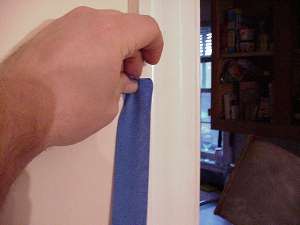|
Prepare to Paint
The first step is to prepare the surface for painting. If you are painting
the entire room, paint the ceiling first. The methods used on the walls are the
same as the ceiling.
Remove any loose paint and debris from the wall. If the area that you are
painting is a kitchen or bathroom it is an excellent idea to clean the wall with
a mild solution in order to remove any grease and/or soap that might be
present. If you are painting over gloss or semi-gloss paint, it is a good idea
to scuff sand the surface. Using a 120 grit piece of sandpaper, lightly sand
the surface. Not so much that you sand into the paint but enough to roughen the
surface. You have to give the new paint the best possible surface to adhere
to. A good primer will help.
When the wall is clean and any debris cleaned up, put down a drop-cloth to
catch any paint splatters. If you are really good with a trim brush you might
skip masking the trim off but, for the rest of us, it is best to mask off any
areas that you do not want to get paint on. These might include moldings around
doors, windows or baseboards. Use masking tape, it is available at the paint
store and it does not stick so tightly as to pull wallpaper or painting from
surfaces. I find the blue 3M tape works best. It does not "shred" like the
traditional yellow masking tape and comes up easier.
Safety Note
Before opening any paint, it is appropriate to talk a bit about safety. You
should wear eye-protection when painting and provide adequate ventilation.
Paint contains solvents that are harmful to humans. Check
the container for specific warnings. Make sure that you open some
windows and use a fan to provide adequate ventilation. If this is insufficient,
use a respirator, increase ventilation or leave the area.
|

|



